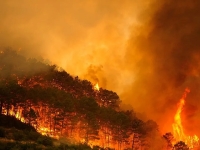Politics
The length of the fire season in Mediterranean countries has doubled
Ukraine and Portugal top the list
USPA NEWS -
Since last January, forest fires in Spain have destroyed more than 290,000 hectares, according to data from the European Forest Fire Information System (EFFIS). The calculations of this European agency reveal that the 2022 fire season in Spain is the worst of the century: in less than seven months, the area burned has already exceeded that which the fire burned in all of 2012, so far the worst year since there are records. The fire burned four times more area than average in early July between 2006 and 2021.
Of the 26 countries for which EFFIS provides data, 16 had already exceeded the average area that had burned by this time in the period 2006-2021 at the beginning of July. Data from the Global Forest Fire Information System (GWIS) for the historical evolution of fires show that Ukraine is the place where the most hectares have burned in recent years in relation to the total area of the country. The fire destroyed more than 7,800 hectares out of every 100,000 in 2008. Another country with a high incidence is Portugal, which experienced a particularly harsh autumn in 2017, exceeding the highest values recorded in 2005 and 2003. For its part, Moldova recorded its worst fire figures in recent years in 2008 and 2014.
A recent study in collaboration with the Spanish Higher Center for Scientific Research (CSIC) reveals that the number of days with extreme fire risk has increased worldwide due to the effects of climate change. The duration of the fire season in the Mediterranean basin has doubled in the last 40 years. A burned forest can take up to 100 years to recover its current state. Climate change has accelerated an alteration that should have taken decades to arrive. In addition, experts predict that forest fires will become more intense, more extensive and more dangerous in the near future.
The worst summer in Spain
In Spain, the first major forest fire this summer was declared on June 8 in the province of Malaga. The fire affected an area inaccessible by land and with a dense grove of chestnut trees, which was already damaged by a fire that devastated more than 9,000 hectares ten months ago. Around 3,000 people were evacuated from the municipality of Benahavís, after what appears to be negligence during maintenance tasks. It is estimated that the fire destroyed some 3,500 hectares.
The first heat wave of the summer, between June 11 and 18, left dozens of fires in 23 of the 52 provinces of Spain. The most destructive was the one that affected the Sierra de la Culebra, a mountainous area in the province of Zamora that is a biosphere reserve and in which almost 30,000 hectares were burned. The fire devastated around 3% of the surface of the province of Zamora and became one of the largest fires so far this century. It was later overtaken by what happened a month later in Losacio, in the same area. Zamora, which already saw more than 2,300 hectares destroyed in Alta Sanabria by a fire that originated in Portugal in January, is the province most affected by fires in 2022.
Faced with the daily data offered by EFFIS from the satellites of the Earth Observation Program of the European Union Copernicus, the Spanish Ministry of Ecological Transition (Miteco) periodically publishes its own calculations with information from the Spanish regions. In mid-August, the first estimated the area burned so far this century at nearly two million hectares. The ministry increased the figure to 2.5 million hectares. The statistics of the Center for the Coordination of National Information on Forest Fires (CCINIF), dependent on the Ministry of Ecological Transition, focuses on fires in which the area burned exceeds 500 hectares. Dozens of fires that occurred in this 2022 have been added to its list of major fires recorded in the last two decades.
The area burned in Spain almost doubles the average of the last decade. A trend that is repeated in the whole of the European Union: the scorched surface is multiplied by three with respect to the average of the last 15 years at this time, according to EFFIS. The voracity of fire in territories where it is not normally a threat -such as Austria, Hungary or Slovakia- together with heat is a phenomenon that experts undeniably associate with climate change.
Liability for this article lies with the author, who also holds the copyright. Editorial content from USPA may be quoted on other websites as long as the quote comprises no more than 5% of the entire text, is marked as such and the source is named (via hyperlink).






